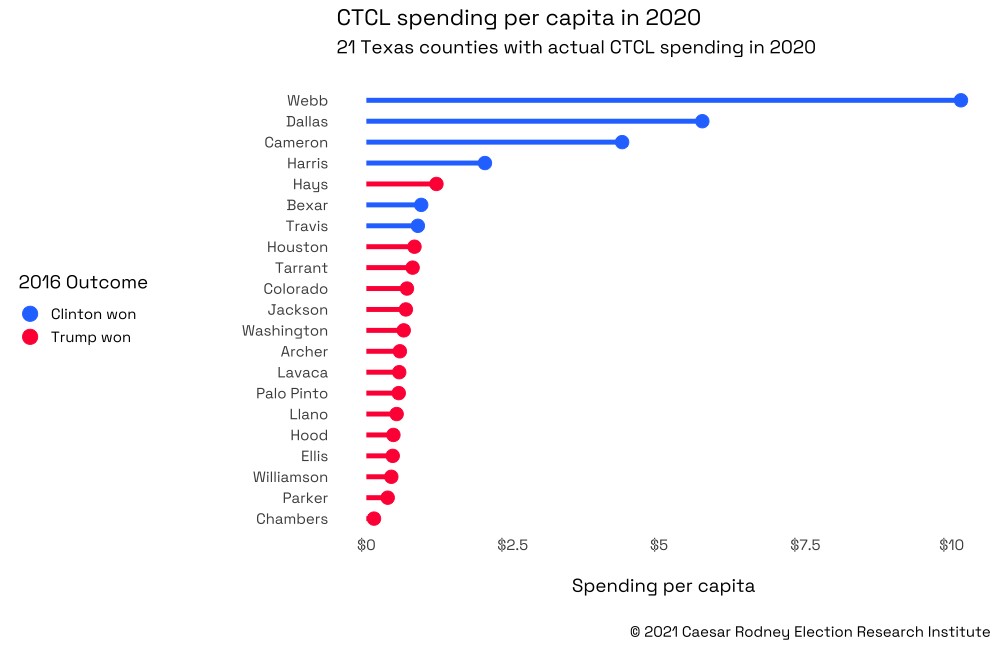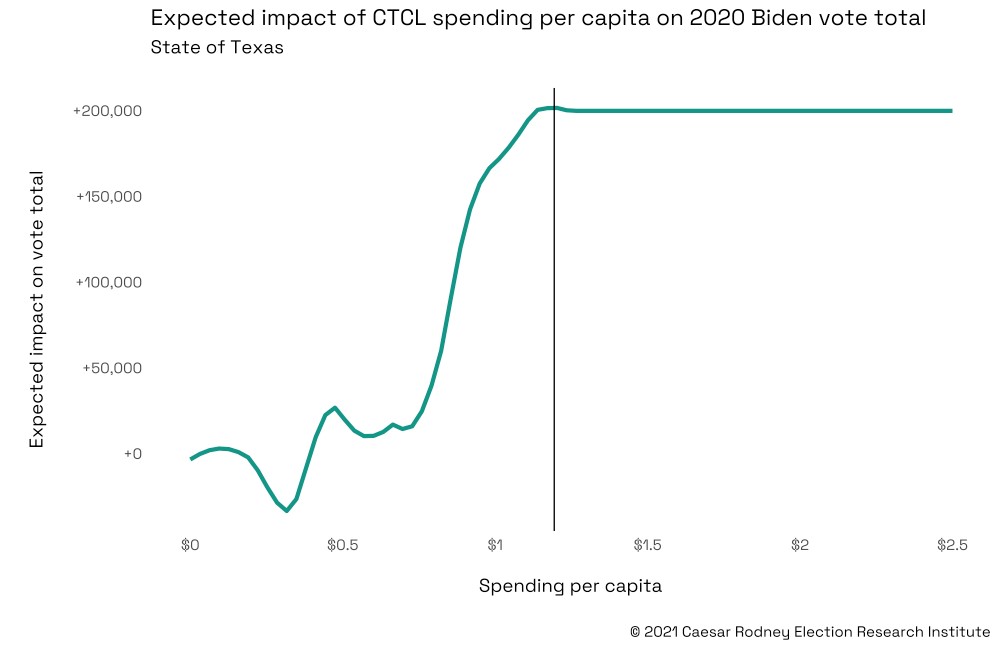The 2020 Election Wasn’t Stolen, It Was Bought By…
The 2020 Election Wasn’t Stolen,
The true story of how Mark Zuckerberg privatized the government's voter registration and vote counting for Democrats in 2020.
During the 2020 election, Facebook CEO Mark Zuckerberg spent hundreds of millions of dollars to turn out likely Democratic voters. But this wasn’t traditional political spending. He funded a targeted, private takeover of government election operations by nominally non-partisan — but demonstrably ideological — non-profit organizations.
Analysis conducted by our team demonstrates this money significantly increased Joe Biden’s vote margin in key swing states. This unprecedented merger of public election offices with private resources and personnel is an acute threat to our republic, and should be the focus of electoral reform efforts moving forward.
The 2020 election wasn’t stolen — it was likely bought by one of the world’s wealthiest and most powerful men pouring his money through legal loopholes.
Partisans Running Local Election Offices
The Center for Technology and Civic Life (CTCL) and The Center for Election Innovation and Research (CEIR) passed a staggering $419.5 million of Zuckerberg’s money into local government elections offices, and it came with strings attached. Every CTCL and CEIR grant spelled out in great detail the conditions under which the grant money was to be used.
This is not a matter of Democrats outspending Republicans. Private funding of election administration was virtually unknown in the American political system before the 2020 election.
Big CTCL and CEIR money had nothing to do with traditional campaign finance, lobbying, or other expenses that are related to increasingly expensive modern elections. It had to do with financing the infiltration of election offices at the city and county level by left-wing activists, and using those offices as a platform to implement preferred administrative practices, voting methods, and data-sharing agreements, as well as to launch intensive outreach campaigns in areas heavy with Democratic voters.
For instance, CTCL/CEIR funded self-described “vote navigators” in Wisconsin to “assist voters, potentially at their front doors, to answer questions, assist in ballot curing … and witness absentee ballot signatures,” and a temporary staffing agency affiliated with Stacey Abrams called “Happy Faces” counting the votes amidst the election night chaos in Fulton County, Georgia.
CTCL demanded the promotion of universal mail-in voting through suspending election laws, extending deadlines that favored mail-in over in-person voting, greatly expanding opportunities for “ballot curing,” expensive bulk mailings, and other lavish “community outreach” programs that were directed by private activists.
CTCL drove the proliferation of unmonitored private dropboxes (which created major chain of custody issues) and opportunities for novel forms of “mail-in ballot electioneering,” allowed for the submission of numerous questionable post-election-day ballots, and created opportunities for illegal ballot harvesting.
CTCL greatly increased funding for temporary staffing and poll workers, which supported the infiltration of election offices by paid Democratic Party activists, coordinated through a complex web of left-leaning non-profit organizations, social media platforms, and social media election influencers.
Staggering Partisan Spending
The amount of additional money these groups poured into elections offices in Democrat-voting areas was truly staggering. To put it in perspective, federal and state matching funds for COVID-19-related election expenses in 2020 totaled $479.5 million. The CTCL and CEIR money totaled $419.5 million. These two private non-profits were responsible for an 85 percent increase in total additional election funding — and that largess was concentrated in a relatively small number of heavily Democratic municipalities.
Although CTCL and CEIR are chartered as non-partisan 501(c)(3) corporations, our research suggests the $419.5 million of CTCL and CEIR spending that took place in 2020 was highly partisan in its distribution and its effects.
Of the 26 grants CTCL provided to cities and counties in Arizona, Georgia, Michigan, North Carolina, Pennsylvania, Texas, and Virginia that were $1 million or larger, 25 went to areas Biden won in 2020. The only county on this list won by Donald Trump (Brown County, Wisconsin) received about $1.1 million—less than 1.3 percent of the $85.5 million that CTCL provided to these top 26 recipients.
But even in Brown County, Wisconsin, where heavily Democrat Green Bay is located, the funding disparities are glaring. The Wisconsin legislature provided roughly $7 per voter to the city of Green Bay to manage its 2020 elections. Rural counties in Wisconsin received approximately $4 per voter.
The CTCL funds boosted Democratic-voting Green Bay resources to $47 per voter, while most rural areas still had the same $4 per voter. Similar funding disparities occurred near Detroit, Atlanta, Philadelphia, Pittsburgh, Flint, Dallas, Houston, and other cities that received tens of millions of dollars of CTCL money.
Preliminary analysis shows this partisan targeting of CTCL funding was repeated in battleground states across the country. Our first case study, however, examines the effect of CTCL spending on the 2020 election in Texas.
The figure below shows the counties that received CTCL spending ranked by per-capita CTCL spending in Texas. As can easily be seen, the counties with the highest per-capita levels of CTCL spending were Democratic counties.

It should be noted that Tarrant County, which contains Fort Worth, is listed as a Republican county but flipped Democrat in 2020. The DFW exurban Denton and Collin Counties, which are solidly Republican, are not included here because they received no CTCL funding.
Funding and managing elections has always been a government function, not a private one, and for good reason. Private organizations are not subject to the rules for public employees and institutions — they are not required to hold public hearings, cannot be monitored via open-records requests and other mechanisms of administrative and financial transparency, are not subject to the normal checks and balances of the governmental process, and are not accountable to voters if the public disapproves of their actions.
The practical effect of these massive, privately manipulated election-office funding disparities was to create a “shadow” election system with a built-in structural bias that systematically favored Democratic voters over Republican voters. The massive influx of funds essentially created a high-powered, concierge-like get-out-the-vote effort for Biden that took place inside the election system, rather than attempting to influence it from the outside.
We call this the injection of structural bias into the 2020 election, and our analysis shows it likely generated enough additional votes for Biden to secure an Electoral College victory in 2020.
How This Money Affected Texas
Although the magnitude and partisan pattern of CTCL and CEIR spending on its face would suggest their efforts harvested a large number of extra Democratic votes, more proof is needed.
We analyzed the likely effects of CTCL and CEIR spending on Biden’s vote margin in 2020 using publicly available data from government reports combined with widely available voter and demographic data. Specifically, we used Bayesian Additive Regression Trees (BART) to “learn” how changes in key election variables impact the change in Biden’s 2020 vote share.
BART is a machine-learning algorithm that is considered a gold standard in making causal inferences. It enables us to avoid mistaking correlation for causation in our estimations.
For each county, we used 1) two-party Hillary Clinton 2016 vote share, 2) turnout percent in 2016, 3) county share of the total state population, 4) geographic location, measured in terms of longitude and latitude, and 5) per-capita CTCL and CEIR spending, to predict changes in Biden’s two-party 2020 vote margin.
The figure below shows the expected impact of per-capita CTCL spending on Biden’s vote total in Texas, according to our model.

The undulating line shows the amount by which Biden’s vote total is expected to change as CTCL’s per-person spending increases. The actual per-capita level of CTCL spending in Texas, represented by the vertical line, is shown to have narrowed Trump’s Texas margin of victory by about 200,000 votes, which, while significant, was not enough to swing Texas into Biden’s electoral vote column.
To put this figure into perspective, however, Ted Cruz’s margin of victory over Beto O’Rourke in Texas’ 2018 Senate race was only 214,921 votes. It is not inconceivable that Democrats would consider a similar effort, were it to take place in 2024, a small price to pay to oust Cruz from his hotly contested Senate seat.
Did Zuck Bucks Flip Wisconsin and Georgia?
Our preliminary results in Georgia and Wisconsin suggest a similar impact on Biden’s vote margin from CTCL spending. And spending in those states was likely large enough and targeted enough to have shifted them into Biden’s column.
This research and analysis project will culminate in the creation of a counterfactual electoral map based on the combined results of our state-by-state analysis. It will reflect how the election results would have looked after the last legal ballot was counted if CTCL and CEIR did not spend their $419.5 million in 2020.
We have good reason to anticipate that the results of our work will show that CTCL and CEIR involvement in the 2020 election gave rise to an election that, while free, was not fair. The 2020 election wasn’t stolen — it was likely bought with money poured through legal loopholes.





Post a Comment